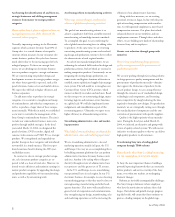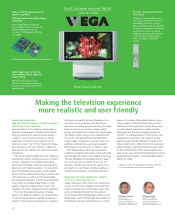Sony 2004 Annual Report Download - page 17
Download and view the complete annual report
Please find page 17 of the 2004 Sony annual report below. You can navigate through the pages in the report by either clicking on the pages listed below, or by using the keyword search tool below to find specific information within the annual report.
15
Chapter two of the VAIO story:
Television picture quality on your PC
Picture quality virtually indistinguishable from an
LCD television—The VAIO type V’s picture quality
has broken the conventions for a PC
Since its debut in 1996, VAIO PC has enhanced
the AV experience of the user through the con-
vergence of audio and visual contents and Sony
took the industry lead through the introduction of
a function that allows users to watch television on
their PC. However, watching television on a PC
used to present problems as, due to the limita-
tions of the PC format, the quality of the televi-
sion images tended to deteriorate as the screen
size increased. In the search for a solution to this
problem, the developers of VAIO turned their
attention to the television technology of Sony’s
Wega, which facilitates outstanding picture qual-
ity. This technology uses a powerful IC chip that,
through Sony’s unique high-quality picture image
circuit Motion Reality, allows the high-quality
display of video images. The engineers thought if
this chip could be utilized, they might be able to
produce images of television quality on a PC
screen. At this point, the developers of VAIO
embarked on a project that would confound the
conventional logic of the PC.
Until then, problems involved with viewing
television on a PC screen had been overcome
through the clever utilization of software or the
optimization of hardware performance. However,
whereas a television screen displays a single, full-
screen image, on a PC the user has the ability to
alter the size of the window, containing the
image as they see fit. Therefore, to produce a
television-quality image on a PC, engineers had to
overcome the challenges of adapting a chip
originally developed for AV devices; optimizing its
performance for the PC; and allowing television-
quality images to be displayed on the adaptable
window sizes of a PC.
VAIO type V is the result of these efforts. Its
20-inch screen generates television images with
quality on a par with those of an LCD television.
With its dazzling picture quality, this new VAIO is
pioneering uncharted territory for PCs.
Never before could a PC have delivered this kind
of enjoyment
But even then, Sony’s engineers chose not to stop
If VAIO type V can be used like a television, then
why can’t it also be used, at the user’s discretion,
to watch television anywhere in the home? To
allow this, the new VAIO has a tilting mechanism
that can be used to angle the screen downward,
a first for a PC. But there’s much more: a 360-
degree swivel stand; a wireless keyboard and
mouse; speakers that deliver high-quality dynamic
sound over a larger area; minimal fan noise; and
much more. All these features add up to make
the VAIO type V everything its creators intended:
a revolutionary PC that is as easy to use as a
television. The PC is also installed with an MPEG
hardware encoder board that can make high-
quality recordings of television programs. A single
remote control handles everything from television
functions to hard disk recordings and DVD opera-
tions. The concept of AV and PC convergence,
central to the VAIO lineup, is now entering a new
phase—one that will open up a new chapter in
PC history.
Yoichiro Hachiya
Assistant Manager
Product Planning Dept.
IT Company
IT & Mobile Solutions Network Company
Naoki Kameyama
Senior Engineering Manager
Hardware Design
Section 3, Department 4
IT Company
IT & Mobile Solutions Network Company
I want to see LCD television-
quality images on my PC
This PC is equipped with Sony’s exclusive
high-quality picture image circuit Motion
Reality. There’s also a fast response 20-
inch television-grade LCD screen
equipped with broad viewing angles.
Furthermore, the Clear Black LCD delivers
a vivid picture with excellent quality
contrast and brightness even when
displaying light colors or jet black.
I only want to see the
keyboard and mouse when
they’re needed
With a wireless keyboard and mouse,
VAIO type V eliminates the need for any
kind of wired connection. The keyboard
and mouse can be put away until
they’re needed again.
Can a PC double as both a
video deck and DVD recorder?
The hard disk drive (HDD) in the VAIO
type V can record up to approximately
103 hours of television programs. The
timer function, used to record programs,
can also be set via the Internet.
It would be great if I could do
everything with a remote
control
The stylish remote control is an integral
part of this PC. At the touch of a button
you can watch television, enter a timer
recording setting, change channels,
adjust the volume or perform various
other tasks.
http://www.sony.net/
File 04: PC “VAIO”
[VGC-V201]
High-quality picture image circuit Motion Reality
The VAIO type V’s AV entertainment menu
























